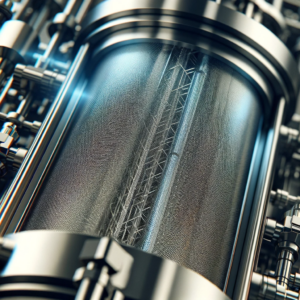
Stainless Steel Wire Mesh Screen Size Chart
I. Introduction
A. Brief Overview of Stainless Steel Wire Mesh Screens
At California Wire Products, we specialize in engineered solutions that meet a wide range of industrial, architectural, and filtration needs with our stainless steel wire mesh screens. Made from various grades of stainless steel, these screens offer exceptional durability against corrosion and rust, making them ideal for use in harsh environments. Their unmatched versatility caters to applications ranging from simple sieving processes to complex architectural designs, emphasizing the critical role of wire mesh screen sizes in various settings.B. Importance of Accurate Sizing in Various Applications
The effectiveness of a stainless steel wire mesh screen is largely determined by its size, including dimensions, mesh count, and wire diameter. Accurate sizing ensures that the screen performs its intended function efficiently, highlighting the importance of a wire mesh size chart for filtration, structural support, or equipment protection in industrial settings. Inaccurate sizing can lead to inadequate protection, process failures, or even safety hazards.C. Purpose of a Size Chart for Stainless Steel Wire Mesh Screens
A size chart for stainless steel wire mesh screens serves as an essential reference tool, aiding users in selecting the right specifications for their applications. By providing detailed information on mesh counts, wire diameters, and the resulting open area percentages, a wire mesh size chart makes it easier to compare different screens, ensuring the chosen mesh meets the required criteria for filtration, strength, and transparency.II. Basics of Stainless Steel Wire Mesh
A. Explanation of Stainless Steel as a Material
Stainless steel, an alloy composed primarily of iron, chromium, nickel, and molybdenum, is celebrated for its resistance to corrosion and oxidation. This resistance is provided by the chromium component, which forms a passive layer of chromium oxide on the surface, protecting the material from external damage. This inherent strength and durability make stainless steel an ideal choice for wire mesh screens, ensuring longevity and reliability in various applications.B. Construction of Wire Mesh Screens
The construction of wire mesh screens involves either weaving or welding stainless steel wires together. In woven mesh, wires are interlaced vertically and horizontally, creating a uniform pattern with precise openings. Welded mesh, on the other hand, involves laying the wires in a grid and fusing them together at the intersections. Each construction method provides unique strengths, with woven mesh offering flexibility and welded mesh providing greater strength and rigidity.C. Common Applications of Stainless Steel Wire Mesh Screens
These screens are integral to a myriad of applications. In filtration, they’re used in water treatment plants and HVAC systems to remove particulates. Architecturally, they can serve both functional and aesthetic purposes, such as in facades or as protective barriers. Industrially, they’re found in machinery for sieving and sorting materials, underscoring their versatility across sectors.III. Importance of Accurate Sizing
A. Impact on Filtration Efficiency
In filtration applications, the size of the mesh openings directly influences the screen’s ability to separate and remove particles from fluids or air. Too large an opening, and unwanted materials pass through; too small, and the flow is restricted, potentially causing pressure drops and process inefficiencies. Accurate sizing, therefore, is paramount to achieving the desired level of filtration without compromising flow rates.B. Influence on Structural Integrity
For applications requiring structural support, such as in building facades or safety barriers, the size and strength of the wire mesh must be sufficient to withstand environmental loads, such as wind, water, and the weight of the structure itself. Incorrect sizing could lead to structural failures, posing risks to both property and human safety.C. Significance in Industrial Processes
In industrial settings, where wire mesh screens are used for sieving, sorting, or as part of manufacturing processes, accurate sizing is critical to ensure product quality, process efficiency, and equipment protection. The right mesh size can separate materials precisely, protect machinery from debris, and facilitate processes like chemical manufacturing, where specific particle sizes are crucial.IV. Creating a Stainless Steel Wire Mesh Screen Size Chart
A. Factors Influencing Screen Size Determination
Understanding the critical factors such as mesh count, wire diameter, and weave pattern is essential for determining the appropriate wire mesh screen sizes. These elements affect the screen’s ability to filter finer particles, its durability, transparency, and flow rates, underscoring the utility of a comprehensive mesh sizes chart in the selection process.B. Standardized Sizing Conventions
This section would detail how standardized sizing conventions, such as those established by ASTM or ISO, provide a framework for consistency and reliability across industries. These standards help in ensuring that screens are produced and utilized with uniformity, facilitating easier selection and compatibility for users worldwide.C. Considerations for Specific Applications
Different applications may require specialized considerations beyond basic sizing. For instance, in corrosive environments, the choice of stainless steel grade becomes crucial, while in architectural applications, aesthetic considerations may influence the choice of weave pattern and wire diameter. Tailoring screen specifications to the application ensures optimal performance and longevity.V. Interpreting the Size Chart
A. Understanding Mesh Count and Openings
Mesh count refers to the number of openings per linear inch in a screen and is inversely proportional to the size of these openings. A higher mesh count indicates smaller particle filtration capability but also reduces the flow rate through the mesh. Understanding how to read and interpret these values is crucial for selecting a mesh that balances filtration needs with flow requirements, ensuring efficiency in processes such as liquid filtration, air purification, and fine particulate separation.B. Comparing Different Wire Diameters and Their Effects
Wire diameter affects the screen’s strength and flexibility. Thicker wires provide greater strength and durability, making them ideal for applications where the screen must withstand physical stress or heavy loads. However, they also decrease the open area, potentially limiting visibility and flow through the mesh. Selecting the right wire diameter is a balance between the structural needs of the application and the functional requirements of filtration or flow.C. Analyzing Weave Patterns and Their Impact on Screen Performance
The weave pattern of a stainless steel wire mesh screen plays a significant role in its overall performance. Plain weaves, characterized by a simple over-and-under pattern, offer a balance of openness and strength, suitable for general use. Twill weaves, where each wire passes over two or more wires before going under, allow for tighter meshes with higher particle retention capabilities. Understanding the implications of different weave patterns helps in selecting the right screen for specific performance criteria, such as filtration efficiency, strength, and durability.VI. Applications and Industries
A. Role of Size Charts in Diverse Industries
Size charts are indispensable tools across various industries, enabling engineers, designers, and end-users to specify and select the most appropriate stainless steel wire mesh screens for their projects. In the food and beverage industry, for example, screens are selected for filtration based on the specific particle sizes to be removed. In the pharmaceutical sector, they are crucial for processes requiring precise particle separation. By providing detailed specifications, size charts facilitate the customization and optimization of screens for specific tasks, enhancing productivity and efficiency.B. Customization for Specific Applications
The ability to customize stainless steel wire mesh screens according to specific application requirements is one of their most valuable attributes. Customization can involve adjusting mesh counts, wire diameters, and weave patterns to achieve desired levels of filtration, strength, and transparency. This tailored approach ensures that screens meet the unique demands of each application, from architectural designs requiring aesthetic appeal to industrial processes needing exact particle separations.VII. Maintenance and Care Tips
A. Extending the Lifespan of Stainless Steel Wire Mesh Screens
Regular maintenance is key to extending the lifespan of stainless steel wire mesh screens. This includes routine inspections for signs of wear or damage, such as corrosion or breaks in the mesh. Preventative measures, like proper installation and use within specified load and environmental limits, also play a crucial role in longevity.B. Cleaning and Storage Recommendations
Proper cleaning techniques can prevent buildup that might clog the mesh or corrode the material. For most applications, gentle washing with water and a mild detergent, followed by thorough drying, is sufficient. When storing screens, keeping them in a dry, ventilated area away from corrosive chemicals or environments ensures their preservation.C. Signs of Wear and When to Replace Screens
It’s important to recognize signs of wear, such as fraying edges, holes, or rust, as these can compromise the screen’s functionality. Regular monitoring helps in deciding when to clean, repair, or replace a screen. Timely replacement is crucial to maintaining the efficiency and safety of the applications they are used in.VIII. Future Trends and Innovations
A. Advances in Stainless Steel Wire Mesh Technology
The continuous advancement in materials science and manufacturing technologies promises even more durable, efficient, and versatile stainless steel wire mesh screens. Innovations may include new alloys with enhanced corrosion resistance, manufacturing techniques that produce more precise and consistent mesh, and coatings that extend lifespan or add functional properties, such as antimicrobial surfaces.B. Emerging Applications and Industries
As technology evolves, so do the applications for stainless steel wire mesh screens. Emerging uses in renewable energy, such as protective coverings for solar panels, or in advanced manufacturing processes, like 3D printing, showcase the adaptability and potential for growth in new markets.C. Potential Developments in Size Chart Standards
Future trends may also include the development of more comprehensive and universal size chart standards, incorporating new metrics for measuring and comparing the performance of screens in innovative applications. These developments could facilitate easier selection and wider adoption of stainless steel wire mesh screens across industries.IX. Conclusion
Stainless steel wire mesh screens from California Wire Products represent a fusion of strength, precision, and versatility. Our wide-ranging applications and potential for customization make them invaluable assets in numerous fields. As technology and applications evolve, so too will the capabilities and uses of these screens, continuing to push the boundaries of what is possible. Proper sizing, guided by a detailed wire mesh size chart, ensures that these screens meet the specific demands of various applications, from industrial filtration to architectural design. Whether you’re designing a new filtration system, seeking solutions for architectural projects, or exploring options for industrial processes, our comprehensive range of stainless steel wire mesh screens at California Wire Products is tailored to meet your needs. Visit our website or contact our expert team for personalized advice and solutions that harness the full potential of stainless steel wire mesh technology. Call us at (951) 371-7730 for more information.FAQs
FAQ 1: Can Stainless Steel Wire Mesh Screens Be Customized for Outdoor Architectural Projects? Yes! Stainless steel wire mesh screens can be customized for outdoor architectural projects to meet specific aesthetic and functional requirements. They can be designed in various weave patterns, mesh sizes, and finishes to complement the exterior design of buildings, providing not only visual appeal but also functionality in terms of sunlight modulation and natural ventilation. FAQ 2: Are There Environmental Benefits to Using Stainless Steel Wire Mesh in Filtration Systems? Absolutely. Using stainless steel wire mesh in filtration systems offers significant environmental benefits. Stainless steel is a sustainable and recyclable material, reducing waste and energy consumption in production and disposal. Additionally, its durability and resistance to corrosion ensure long-lasting performance in filtration systems, minimizing the need for frequent replacements and thus lessening environmental impact over time. FAQ 3: How Does the Choice of Weave Pattern Affect the Application of Stainless Steel Wire Mesh Screens in Industrial Settings? The choice of weave pattern significantly impacts the application of stainless steel wire mesh screens in industrial settings. Different weave patterns offer varying degrees of strength, flexibility, and filtration precision. For example, a denser weave pattern might be chosen for applications requiring fine particle filtration, while a more open weave might be preferred for processes needing higher flow rates. Selecting the appropriate weave pattern ensures that the mesh meets the specific demands of the industrial process, optimizing efficiency and productivity.GET IN TOUCH
Contact us today to place your wire mesh order!


